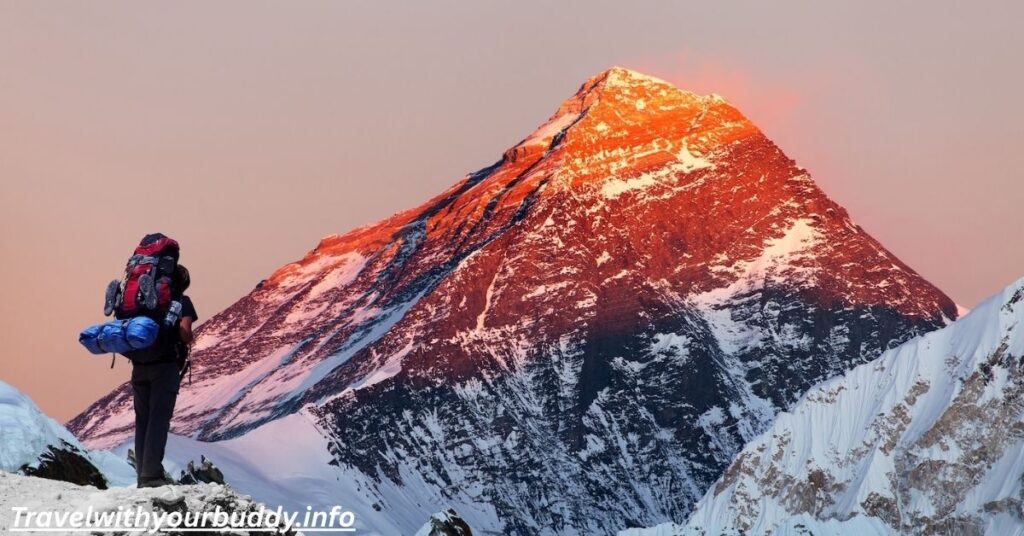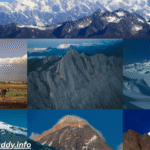The highest mountains in the world rise far above sea level. These peaks stretch into the sky, touching the edges of Earth’s atmosphere. The tallest summits offer stunning views, spiritual meaning, and brutal climbing challenges. Most of the eight-thousanders are in the Himalayan Mountains and the Karakoram Range. These geological marvels attract adventurers, climbers, and dreamers alike.
In this guide, we’ll dive into the top 15 highest mountains in the world. We’ll look at their height, location, history, and why they matter. Whether you’re into mountaineering, adventure travel, or just enjoy learning about the world, this article will take you on a high-altitude journey.
What is a Mountain?
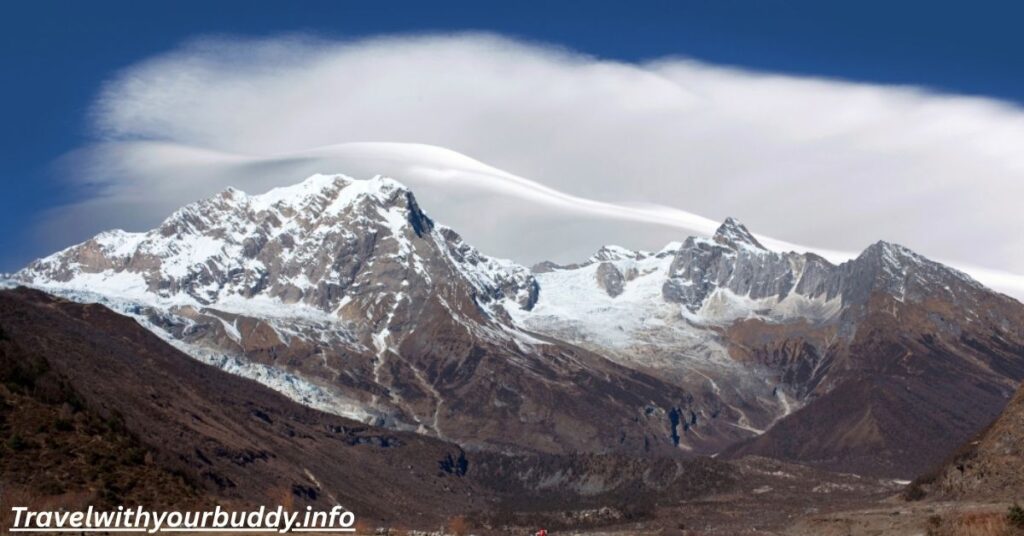
A mountain is a large natural elevation of the Earth’s surface. It stands much taller than the surrounding land. Most mountains are formed by tectonic forces. When Earth’s plates crash together, they push land upward, creating massive peaks. Over millions of years, these become today’s towering summits.
Mountains must rise at least 1,000 feet above the land around them to be called mountains. Some are formed by volcanic activity, while others come from folded layers of Earth. Their geographical features vary by region. In the U.S., the Rockies and Alaska Range have famous peaks. In Asia, the Himalayan Mountains dominate the sky.
What is the Highest Mountain in the World?
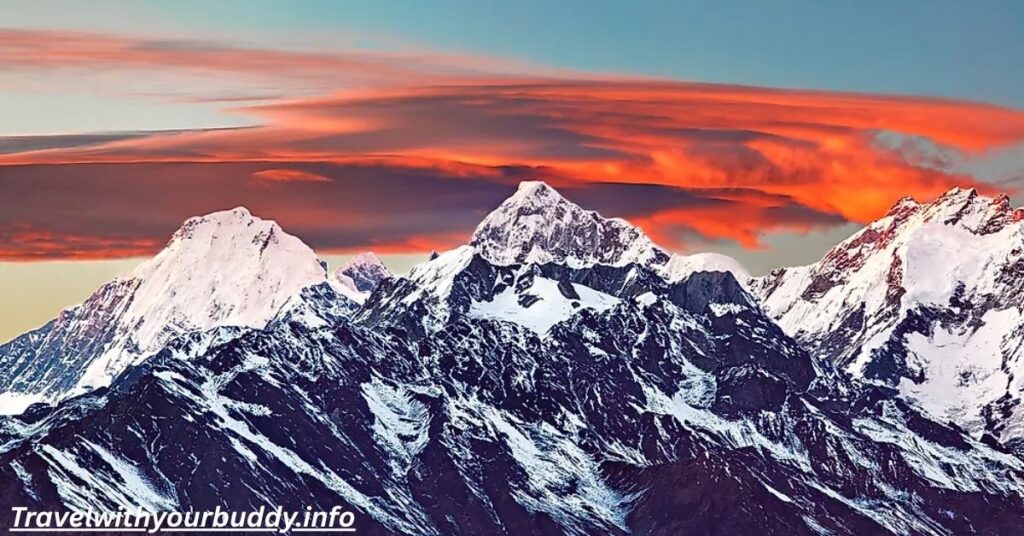
The answer is simple: Mount Everest. Everest stands at 8,848.86 meters, or 29,032 feet Highest Mountains in the World. It sits on the border between Nepal and Tibet. Everest is part of the Himalayan Mountains and is the tallest among all eight-thousanders. It has become a symbol of human determination and extreme endurance.
Climbing Everest is a major mountaineering achievement. Thousands try each year. Many succeed, but some never return. The trek to base camp alone is a popular form of high-altitude trekking. But reaching the summit is a deadly serious challenge. The risk of altitude sickness, frostbite, and treacherous terrain makes it one of the hardest climbs in the world.
The Top 15 Highest Mountains in the World
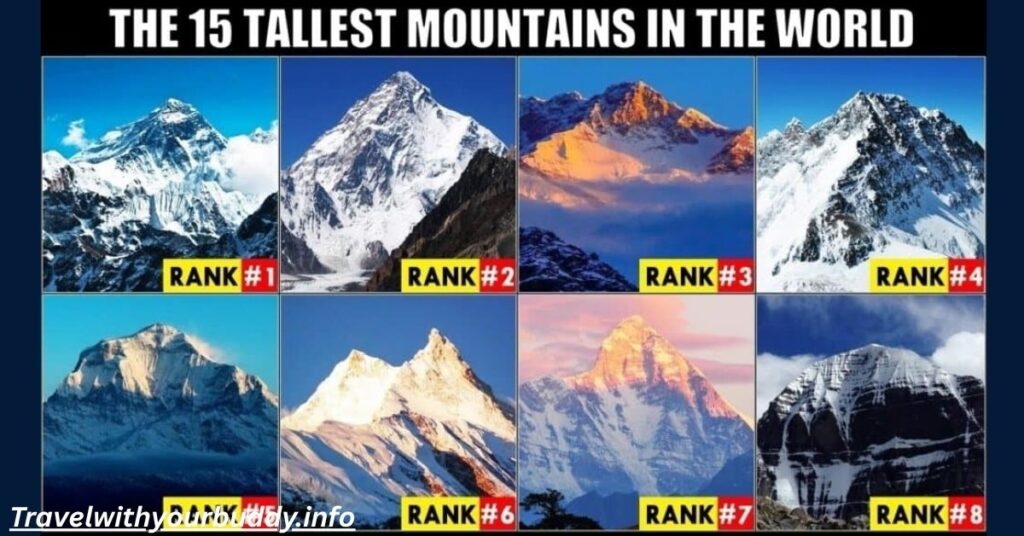
All the world’s tallest mountains are found in Asia. Most are in the Himalayas and Karakoram Range. Each one is over 8,000 meters tall. These are known as the eight-thousanders. Climbing any one of them is a huge climbing expedition. The table below shows key details of each peak.
| Rank | Mountain | Height (m/ft) | Range | Country |
| 1 | Mount Everest | 8,848 / 29,032 | Himalayan Mountains | Nepal / China |
| 2 | Mount K2 | 8,611 / 28,251 | Karakoram Range | Pakistan / China |
| 3 | Kangchenjunga | 8,586 / 28,169 | Himalayan Mountains | Nepal / India |
| 4 | Lhotse | 8,516 / 27,940 | Himalayan Mountains | Nepal / China |
| 5 | Makalu | 8,485 / 27,838 | Himalayan Mountains | Nepal / China |
| 6 | Cho Oyu | 8,188 / 26,864 | Himalayan Mountains | Nepal / China |
| 7 | Dhaulagiri I | 8,167 / 26,795 | Himalayan Mountains | Nepal |
| 8 | Manaslu | 8,163 / 26,781 | Himalayan Mountains | Nepal |
| 9 | Nanga Parbat | 8,126 / 26,660 | Himalayan Mountains | Pakistan |
| 10 | Annapurna I | 8,091 / 26,545 | Himalayan Mountains | Nepal |
| 11 | Gasherbrum I | 8,080 / 26,509 | Karakoram Range | Pakistan / China |
| 12 | Broad Peak | 8,051 / 26,414 | Karakoram Range | Pakistan / China |
| 13 | Gasherbrum II | 8,035 / 26,362 | Karakoram Range | Pakistan / China |
| 14 | Shishapangma | 8,027 / 26,335 | Himalayan Mountains | China (Tibet) |
| 15 | Gyachung Kang | 7,952/ 26,089 | Himalayan Mountains | Everest |
“Each mountain has its own story”
Mount Everest: Highest Mountains in the World
Mount Everest is the world’s tallest peak. It lies in the Himalayan Mountains and reaches 8,848 meters. Climbers from across the globe take on this iconic summit challenge. Its height and location create extreme conditions. Snow, ice, and wind make it a deadly climb.
Mount K2
Mount K2 is part of the Karakoram Range. It is 8,611 meters tall and lies between Pakistan and China. It is known for its treacherous terrain. Many climbers say it is harder than Everest. Fewer have reached the summit. The mountain is feared but deeply respected.
Kangchenjunga
Kangchenjunga is the third-highest mountain at 8,586 meters. Located between Nepal and India, it holds spiritual significance for locals. The weather and avalanches make climbing dangerous. Still, it draws many who seek a great mountaineering achievement.
Lhotse
Lhotse is close to Everest and stands at 8,516 meters. The mountain is linked with the Everest Base Camp trail. Its steep ice walls test every climber. The views are stunning, but the climb is not for beginners.
Makalu
Makalu, the fifth tallest, rises to 8,485 meters. It lies southeast of Everest. This mountain has sharp ridges and steep slopes. It offers some of the toughest climbing routes in the Himalayan Mountains.
Cho Oyu
Cho Oyu stands at 8,188 meters. It is known as the easiest of the eight-thousanders. This makes it popular with less-experienced climbers. However, weather and thin air still pose major risks.
Dhaulagiri I
Dhaulagiri I reaches 8,167 meters. Located in Nepal, it offers one of the best views on the Annapurna Circuit. Few dare to climb it. The mountain is snowy, steep, and very remote.
Manaslu
Manaslu is 8,163 meters tall and also in Nepal. It means “Mountain of the Spirit” in Sanskrit. Climbing Manaslu is a long climbing expedition. It involves navigating icefalls, crevasses, and risk of altitude sickness.
Nanga Parbat
Nanga Parbat is in Pakistan and stands at 8,126 meters. Its name means “Naked Mountain.” It is part of the Himalayan Mountains. The climb is extremely dangerous. High winds and avalanches make it deadly.
Annapurna I
Annapurna I is 8,091 meters high. It is the most dangerous eight-thousander. Nearly one-third of climbers do not survive. However, the Annapurna Circuit around the mountain is a popular trek.
Gasherbrum I
Gasherbrum I is 8,080 meters tall. It’s part of the Karakoram Range. The name means “Shining Wall.” Climbers face harsh cold and sharp ridges. Yet it offers deep beauty and silence.
Broad Peak
Broad Peak reaches 8,051 meters. It lies near Mount K2. The summit ridge is long and wide. That’s how it got its name. It’s a favorite among experienced mountaineers.
Gasherbrum II
Gasherbrum II is slightly shorter at 8,035 meters. It’s often climbed along with Gasherbrum I. The peak is icy and remote. Climbers must be ready for long days and bad weather.
Shishapangma
Shishapangma is 8,027 meters tall. It is the only eight-thousander fully inside China. It is less known but still difficult. Snowstorms and winds test climbers to their limits.
Gyachung Kang
Just below the eight-thousander mark is Gyachung Kang. It stands at 7,952 meters or 26,089 feet. It is the highest peak that doesn’t make the 8,000-meter club. Located in the Himalayan Mountains, it sits between Cho Oyu and Everest. Though it’s often overlooked, it remains a serious climbing expedition.
Gyachung Kang doesn’t attract as many climbers. It lacks the fame of other peaks. But it offers the same harsh conditions and breathtaking views. For true mountaineers, it remains a gem worth noting.
Why the Highest Mountains in the World Matter
The highest mountains in the world aren’t just tall. They shape cultures, fuel legends, and inspire millions. These peaks test the limits of strength, will, and survival. Their summit challenge pushes climbers to new levels.
Every time a climber reaches the top, it adds to the expedition history of that mountain. The views from the top may be brief, but the journey lives on. That’s why people keep returning to the highest mountains in the world. The magic of these places is real.
Nature, danger, beauty, and spirit all come together in the highest mountains in the world. They are more than just rock and snow—they are symbols of what’s possible.
FAQ’s: Highest Mountains in the World
1. What is the highest mountain in the USA?
That would be Denali, in Alaska. It stands at 6,190 meters or 20,310 feet. It’s also part of The Seven Summits, a list of the highest mountains on each continent.
2. Why are the tallest mountains in Asia?
This is due to massive tectonic plate collisions. The Indian and Eurasian plates crash and push up the land. That’s how the Himalayan Mountains and Karakoram Range formed.
3. How many eight-thousanders are there?
There are 14 official eight-thousanders. All are in Asia.
4. Which peak is the most dangerous?
Annapurna I is the deadliest. It has the highest fatality rate.
5. Is climbing Everest easy now?
Not at all. While gear has improved, altitude sickness, weather, and treacherous terrain still pose huge risks.
6. Can beginners climb any of these?
Cho Oyu is often climbed by those new to high peaks. But even that needs serious training.
Final Thoughts: Highest Mountains in the World
The highest mountains in the world represent more than just elevation. They show the power of Earth’s forces. They test human determination and skill. Each peak tells a story of expedition history, natural wonder, and spiritual depth.
From climbing routes to sacred myths, these peaks shape culture, nature, and dreams. Whether you’re planning a climbing expedition or simply admiring their beauty, these mountains remind us how small we are, yet how far we can go.
The journey to the top isn’t just about height. It’s about heart, courage, and the will to rise.

I’m Freya Collins, an experienced travel writer passionate about helping others explore the world. At TravelWithYourBuddy.info, I share practical tips, guides, and insights from my journeys to inspire confident and meaningful adventures.

